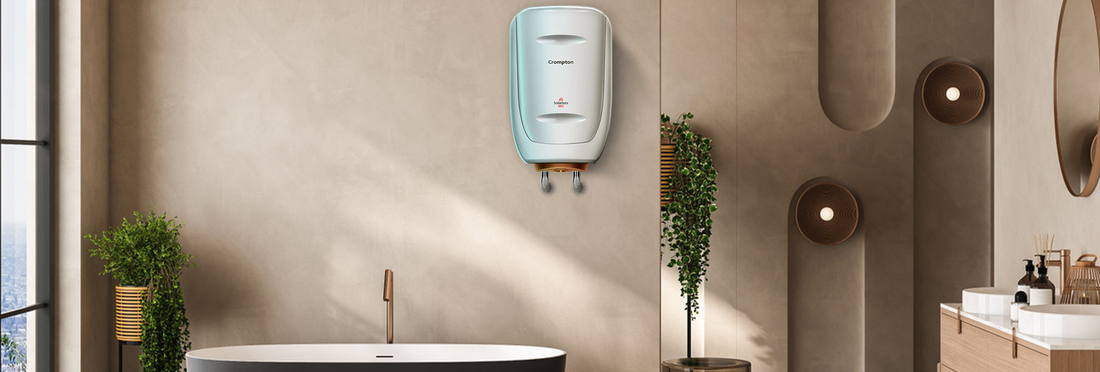Types of Solar Water Heater


Types Of Solar Water Heater - Everything You Need to Know
Today, the importance of sustainable living and effective utilisation of energy resources can’t be stressed enough. Solar water heaters are a reliable and eco-friendly solution for effective use of solar energy that contribute to sustainable living. In this article, you can get information on the types of solar water heaters and why they are the right choice for sustainable use of energy.
What Are Solar Water Heaters?
Solar water heaters are devices designed to harness the abundant and free energy of the Sun to heat water. These devices capture and utilise solar energy to raise the temperature of water to a comfortably warm range, typically between 60-80 degrees Celsius. A solar water heater has four major components:
- Solar collector to absorb solar energy,
- Insulated tank for hot water,
- Supporting stand,
- Connecting pipes and other instrumentation.
The collector panel, which absorbs solar energy, is equipped with a black absorbing surface known as the absorber. The absorbed energy is then efficiently transferred to the water circulating through the collector. The heated water is collected in a specially designed tank, which is equipped with insulation to minimise heat loss. The circulation of water between the tank and the collector happens automatically. This circulation ensures that the water in the tank is consistently heated by the sun's energy, providing a reliable and steady supply of hot water.
What Are the Different Types of Solar Water Heaters?
Depending on the collector system used, solar water heaters can be classified into the following two types:
• Flat Plate Tube Collector
The flat plate tube collector consists of a flat, rectangular panel that absorbs sunlight and heats up water inside tubes or channels. The heat absorbing panels are typically made of copper or aluminium – materials that are excellent conductors of heat. The heated water is then transferred to a storage tank, where it can be used for various heating purposes.
• Evacuated Tube Collector
The evacuated tube collector consists of double-layered borosilicate glass tubes, each with a metal absorber tube inside. These tubes are highly insulated and create a vacuum, which minimises heat loss. When sunlight hits the absorber tube, it heats up the water inside, which is then transferred to a water heater storage tank.
Types of Solar Water Heating Systems
Flat-panel and tube collector water heater systems are further divided into two different system categories: Active and Passive.
Active: These systems employ pumps and controls to utilise forced circulation for the movement of the working fluid.
- Closed Loop Systems: In this system, a heat transfer fluid and heat exchanger are used to heat the service water. They are used in cold climates to prevent freezing. Additionally, closed loop systems are useful in areas with hard or acidic water, which can lead to scale deposits that obstruct or corrode the fluid passages.
- Open Loop Systems: This system directly heats the service water through the collector. However, due to their exposure to outside air, they are more vulnerable to corrosion. Therefore, it is essential to implement adequate precautions to prevent corrosion in open loop systems.
Passive: These systems operate without the need of pumps or other instrumentation.
- Thermosyphon System: It functions on the principle of natural convection. Here, water flows from the bottom of the tank into the solar collector, where it absorbs heat. As the water warms up, it becomes less dense and rises back to the tank. This cycle continues until the temperature differential at the bottom and top equalises.
- Built-in Storage System: Its collector and storage units are integrated together to minimise space requirements. It is used within well-insulated parabolic or rectangular cases with double glazing. These systems use highly reflective foil on the inner casing to redirect more sunlight. The cylindrical metallic absorber and storage unit are coated with selective coatings to maximise heat absorption during daylight hours while minimising heat loss during the dark.
Advantages of Solar Water Heaters
Here’s why more households should opt for solar water heaters:
- Energy savings: Solar water heaters significantly reduce your electricity or gas consumption, leading to lower energy bills.
- Environmentally friendly: By using the sun's energy, you reduce your carbon footprint and contribute to a cleaner environment.
- Long-term savings: While the initial investment in a solar water heater may be higher, the long-term savings on energy bills make it a financially wise choice.
- Government incentives: Governments offer various incentives, tax credits, or rebates to encourage the adoption of solar water heaters, making them more affordable.
From instant geysers to storage water heaters, elevate your shower experience with Crompton’s wide range of electrical water heaters.

 Read Previous Blog
Read Previous Blog-(1)-v1758272419763.jpg?1667x1667)



 at 9228880505 or write to us at
at 9228880505 or write to us at 